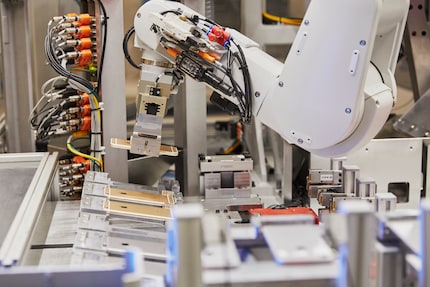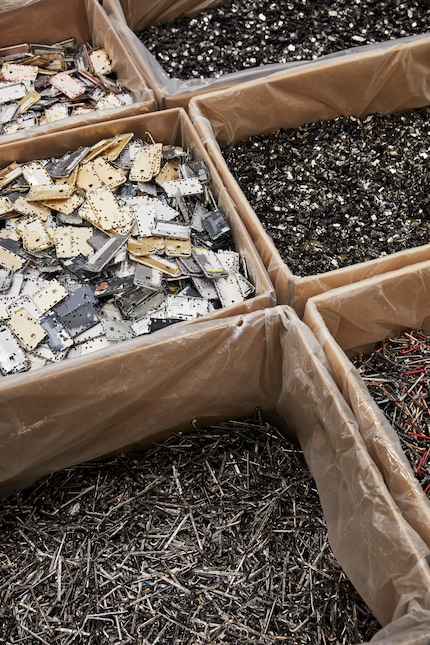
Background information
Apple’s marketing in 11 songs
by Dayan Pfammatter

Apple has set itself the goal of being carbon neutral by 2030. A robot named «Daisy» is expected to play a small part in this. The machine can disassemble an iPhone in just a few seconds.
You might be thinking to yourself: «Not another sustainability story.» But please, don’t click away just yet! After all, I travelled all the way to the Dutch province of North Brabant, more precisely to Breda, to research this story. There, inside a factory building in a nondescript industrial area – as industrial areas usually are – you’ll find a robot. It disassembles old iPhones with the goal of recovering as many of the raw materials they contain as possible.
OK, so basically nothing more than well-marketed electronics recycling? That was also my first thought after being invited by Apple to visit «Daisy». And I’m severely put off by greenwashing. However, Apple assured me that they’d talk openly and that the company’s strategic sustainability experts had come over from the USA. Alright then. Together with a handful of other journalists, we left for Breda at the crack of dawn. Much of what was said there was «off the record» to help us fully understand, so I won’t be quoting that. This is quite common in journalism, and Apple is known for its secrecy. We couldn’t film or photograph anything during our visit. With only a pad and pencil, we entered the massive factory hall, as big as a football field. And there she is, in her own section: «Daisy». All images in this article, and the video, were provided by Apple.
Talking to Apple’s people about sustainability was actually more refreshing than trying to find out about possible new products. In any case, my impression is that there are people there who care a great deal about the earth’s future and their role in it, and who have the wherewithal to tinker with solutions. To be expected, with a company annual profit of $95 billion in 2021 (graph in German). That’s more than the gross domestic product of Ghana or Croatia.
But back to «Daisy». It isn’t a humanoid robot, like the one Tesla founder Elon Musk is having developed. Rather, it’s an array of robotic arms that grab old iPhones and disassemble them in a few steps.

Since 2012, Apple has been working on a way to dismantle iPhones that preserves many of the raw materials used in them for further use. «Daisy’s» predecessor was called «Liam». At the time, it took him around twelve minutes to take apart an iPhone 5. «Liam 2,» in use in 2015 and 2016, needed only 11 seconds for the iPhone 6. The robot was also 30 metres long, and basically a reverse production line – with 29 stations. It was clear to Apple’s engineers that such a monstrosity wouldn’t be scalable to eventually dismantle several million devices per year. Add onto that all the various iPhone models.
So the engineers tried another approach. While both «Liams» were still designed to gently and carefully disassemble an iPhone into individual parts, for example by unscrewing it, «Daisy» is allowed to work more brutally. The display and casing are wrenched open, the battery is cut out, up to 60 screws get ripped out, and any other components are simply pulled apart.
Individual parts are then sorted by hand. This might also become automated in a next step, with the help of cameras that recognise the shape of individual parts. In the end, the batteries, loudspeaker, hearing module, camera module, Wi-Fi component, motherboard and vibration motor end up in their own large boxes. Still not looking like they could be used to make new iPhone parts. Which is why more robots take over moving forward. Take «Dave», who recovers rare-earth magnets, tungsten and steel from a vibration engine, called Taptic Engine at Apple (see video here).

Finally, «Taz» uses new shredder-like technology to separate magnets from audio components and recover more rare earth minerals. Regarding recycling, Apple is working with Carnegie Mellon University in Pittsburgh, among others, to sort e-waste even better.
«Daisy» in Breda could dismantle up to 1.2 million iPhones per year. In Austin, Texas, where a second identical «Daisy» is located, the same capacity is also feasible. No one revealed to me exactly how many iPhones are being dismantled at Apple. But the company makes no secret of the fact that they could potentially recycle even more. Both machines are currently underutilised.
In any case, recycling would be a win for the environment. One ton of iPhone components removed by «Daisy» contain as much gold and copper as 150 tons of ore from a mine. Thus, recycled material has a much lower carbon footprint.
And Apple is increasingly using this remanufactured material for new devices. For example, all new products introduced in 2021 contained recycled rare earth materials. Not a complete sea change, but it’s getting there. The iPad and MacBook are the forerunners when it comes to aluminium: their cases are now made of 100 per cent recycled materials, as stated in Apple’s annual environmental report.
«Daisy» is a mortician for when your iPhone has finally breathed its last. The end of an electronic device’s life is a good time to take stock of its environmental impact. The ecological footprint of an iPhone, measured in CO2, is particularly large due to the manufacturing process and the raw materials required. Specifically, 70 per cent of all CO2 is released during production, while only 22 per cent is released during its lifetime. The remaining eight per cent is attributable to packaging and transport.
That’s why Apple is overhauling its production and materials. In recent years, the lifetime CO2 emissions of iPhones have already decreased significantly.
Putting the above graph into perspective: a 350-kilometre drive in an average internal combustion car produces a similar amount of CO2 as a new iPhone. A single flight from Zurich to Hamburg, on the other hand, is significantly more CO2-intensive at 173 kilograms.
Another advantage for Apple is that iPhones are usually in use much longer than rival smartphones – Fairphone excluded. Initial emissions during production are thus spread over a longer period of use. Apple doesn’t know exactly how long an iPhone is used on average. It’s well known that a pre-owned iPhone will be in use for at least the same amount of time as it had been by the original owner. This is backed up by Apple’s update policy, which usually guarantees the latest iOS version for five years after a model’s release. And older devices will still continue to run, simply with an outdated operating system. Accordingly, Apple devices still fetch good resale prices. Numerous iPhone models can also be found on digitec’s resale platform, although nowhere near as many as on other Swiss platforms such as Ricardo or Tutti or on E-Bay in Germany and Austria.
For Android devices, the period in which software updates are guaranteed is shorter, depending on the manufacturer. However, big brands in particular are trying to get closer to Apple.
After a four-hour programme with robot tours and some exciting conversations, one thing’s for sure: Apple’s «Daisy» certainly won’t be able to save the world on its own. Nearly 240 million iPhones were sold in 2021. The amount recycled at Apple is only one per cent of that. Now Apple didn’t phrase it that way, but it was quite easy for me to calculate.
The bottom line is: too many devices still end up in regular recycling or simply gather dust in drawers. I too still own an older iPhone model that’s completely dead. I’d have loved to stick it straight into «Daisy», but this wasn’t possible due to some security reason. Looks like I’ll just have to bring it to my nearest Apple Store and have it recycled for free. If you and other readers of this article do this too, we’ll certainly make «Daisy’s» day – and the carbon emissions caused by my trip to the Netherlands will be compensated.
Journalist since 1997. Stopovers in Franconia (or the Franken region), Lake Constance, Obwalden, Nidwalden and Zurich. Father since 2014. Expert in editorial organisation and motivation. Focus on sustainability, home office tools, beautiful things for the home, creative toys and sports equipment.
Interesting facts about products, behind-the-scenes looks at manufacturers and deep-dives on interesting people.
Show all